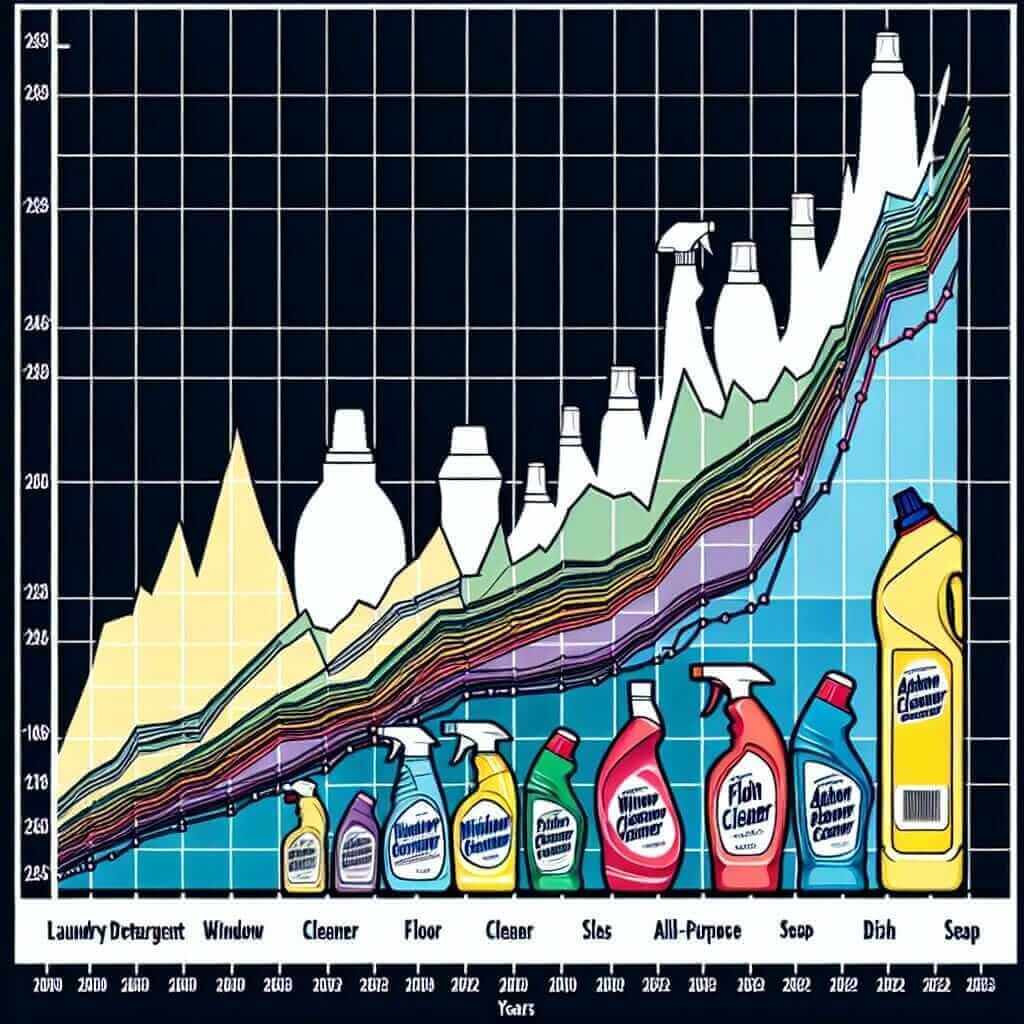The topic “Sales of Different Types of Cleaning Products (2000-2023)” is highly relevant for IELTS Writing Task 1, where candidates are often required to describe visual information. This rarely comes up directly in exams, but the skills you gain in synthesizing and describing data can be universally applied.
Common IELTS Task 1 Essay Questions
IELTS Writing Task 1 often features questions that ask you to describe charts, graphs, and tables. Here are a few sample questions related to our topic:
-
Line Graph:
“The graph below shows the sales of different types of cleaning products from 2000 to 2023. Summarize the information by selecting and reporting the main features, and make comparisons where relevant.” -
Bar Chart:
“The bar chart below shows the sales of five types of cleaning products in the years 2003, 2013, and 2023. Summarize the information by selecting and reporting the main features, and make comparisons where relevant.” -
Table:
“The table below provides information about the sales of various cleaning products for the years 2000, 2010, and 2020. Summarize the information by selecting and reporting the main features, and make comparisons where relevant.”
Analysis of Selected Question: Line Graph
Question:
“The graph below shows the sales of different types of cleaning products from 2000 to 2023. Summarize the information by selecting and reporting the main features, and make comparisons where relevant.”
Data Representation
Let’s create a hypothetical line graph for this:
| Year | Laundry Detergent | Window Cleaner | Floor Cleaner | All-Purpose Cleaner | Dish Soap |
|---|---|---|---|---|---|
| 2000 | 50 | 30 | 20 | 40 | 25 |
| 2005 | 60 | 35 | 30 | 45 | 30 |
| 2010 | 70 | 40 | 40 | 50 | 35 |
| 2015 | 80 | 45 | 45 | 60 | 40 |
| 2020 | 90 | 55 | 50 | 65 | 50 |
| 2023 | 100 | 60 | 55 | 70 | 60 |

Analysis
Introduction
When writing your introduction, always paraphrase the question.
Example:
“The line graph illustrates the sales of five different types of cleaning products—laundry detergent, window cleaner, floor cleaner, all-purpose cleaner, and dish soap—from 2000 to 2023.”
Overview
Your overview should highlight the general trends without going into too much detail.
Example:
“Overall, the sales of all types of cleaning products showed an upward trend over the 23-year period. Among them, laundry detergent consistently had the highest sales, while floor cleaner sales were the lowest until 2005, and dish soap had the least but showed a steady increase over the years.”
Detailed Trends and Comparisons
Here you can analyze the data more deeply, breaking it down into manageable pieces.
Example:
“From 2000 to 2005, the sales of laundry detergent increased by 10 units, from 50 to 60. A similar trend was observed in window cleaner and floor cleaner, which saw increases of 5 and 10 units respectively. The sales of all-purpose cleaner and dish soap rose steadily by 5 units each during the same period.”
“Between 2005 and 2015, there was a significant increase in the sales of all cleaning products. Laundry detergent increased from 60 to 80 units, marking a rise of 20 units. The sales of window cleaner, floor cleaner, and dish soap also saw substantial increases, reaching 45, 45, and 40 units, respectively, by 2015.”
“From 2015 to 2023, the sales of all cleaning products continued to rise, albeit at a slightly slower pace. By 2023, laundry detergent reached 100 units, becoming the most sold product, followed by all-purpose cleaner, which reached 70 units. Window cleaner and floor cleaner sales were relatively close, with 60 and 55 units sold respectively. Dish soap sales also saw a satisfactory increase, reaching 60 units.”
Conclusion
You can end by summarizing the main trends and noting any significant patterns or anomalies.
Example:
“To conclude, the sales of all types of cleaning products have consistently increased from 2000 to 2023. Laundry detergent remained the leading product, while dish soap, despite being the least sold initially, showed notable growth over the years.”
Useful Vocabulary and Phrases
- Paraphrasing: illustrate, demonstrate, show, depict.
- Trends: upward trend, steady increase, significant rise.
- Comparisons: higher, lower, more than, less than.
- Quantifying: units, figures, numbers.
- Time: over the period, from [year] to [year], during the [specific years].
Important Words and Their Usage
-
Illustrate (verb) /ˌɪl.əˈstreɪt/: Show something with examples or graphics.
Example: “The graph illustrates the sales from 2000 to 2023.” -
Consistent (adjective) /kənˈsɪs.tənt/: Unchanging in achievement or effect over a period of time.
Example: “Laundry detergent sales remained consistent over the years.” -
Trend (noun) /trend/: A general direction in which something is developing or changing.
Example: “An upward trend can be observed in all the product sales.” -
Significant (adjective) /sɪɡˈnɪf.ɪ.kənt/: Sufficiently great or important to be worthy of attention.
Example: “There is a significant increase from 2000 to 2023.” -
Substantial (adjective) /səbˈstæn.ʃəl/: Of considerable importance, size, or worth.
Example: “Substantial growth was noted in the sale of window cleaner.”
Reminders
- Data Integrity: Always refer to the data accurately while making comparisons.
- Linking Words: Use connectors like “while,” “however,” “meanwhile” to transition between thoughts smoothly.
- Avoid Repetition: Use synonyms to avoid redundancy.
- Grammar and Spelling: Double-check for errors to effortlessly gain those extra points.
Conclusion
Understanding how to write about trends, comparisons, and data over a period can greatly benefit your IELTS Writing Task 1 performance. Remember to review each section of your report diligently, ensuring it accurately reflects the data while maintaining coherence and cohesion. With dedicated practice, you can achieve a Band 7 or higher.
Happy studying!